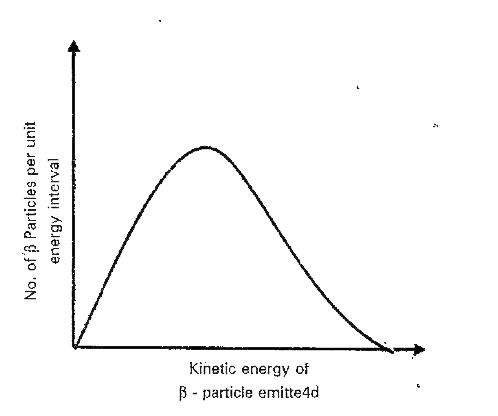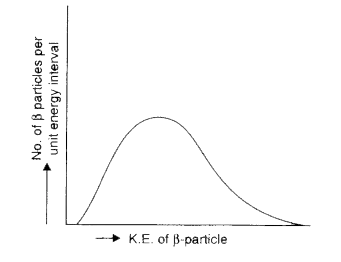Consider the decay of a free neutron at rest : n→p+e− Show that the two body decay of this type must necessarily give an electron of fixed energy and , therefore, cannot account for the observed continuous energy distribution in the β- decay of a neutron or a nucleus (Fig).

(Note : The simple result of this exercise was one among the several arguments advanced by W. Pauli to predict the existence of a third particle in the decay products of β - decay. This particle is known as neutriono . We now know that it is a particle of intrinsic spin1/2 (like e- , p or n) , but is neutral, and either masslessor having an extremely small mass (compared to the mass of electron) and which interacts very weakly with matter. The correct decay process of neutron is : n→p+e−+v
In the decay process, n→p+e
energy of electrons is equal to (Δm)c2
where Δm = mass defect = mass of neutron - mass of proton and electron ,
which is fixed. Therefore , two body decay of this type cannot explain the observed continuous energy distribution in the β - decay of a neutron or a nucleus
Similar Questions
Consider the decay of a free neutron at rest: n⊤+e− Show that the tow-body dacay of this type must necessarily give an electron of fixed energy and, therefore, cannot for the observed continous energy distribution in the β-decay of a neutron or a nucleus.
 View Solution
View SolutionConsider the decay of a free neutron at rest: n⊤+e− Show that the tow-body dacay of this type must necessarily give an electron of fixed energy and, therefore, cannot for the observed continous energy distribution in the β-decay of a neutron or a nucleus.
 View Solution
View SolutionConsider the decay of a free neutron at rest: n⊤+e− Show that the tow-body dacay of this type must necessarily give an electron of fixed energy and, therefore, cannot for the observed continous energy distribution in the β-decay of a neutron or a nucleus.
 View Solution
View SolutionThe decay of a proton to neutron is :
View SolutionProton can decay into neutron
View SolutionIs free neutron a stable particle ? If not, what is its mode of decay?
View SolutionA free neutron decays spontaneously into
View SolutionA free neutron decays spontaneously into
View SolutionA free neutron decays into a proton, an electron and
View SolutionA free neutron decays into a proton, an electron and
View Solution

